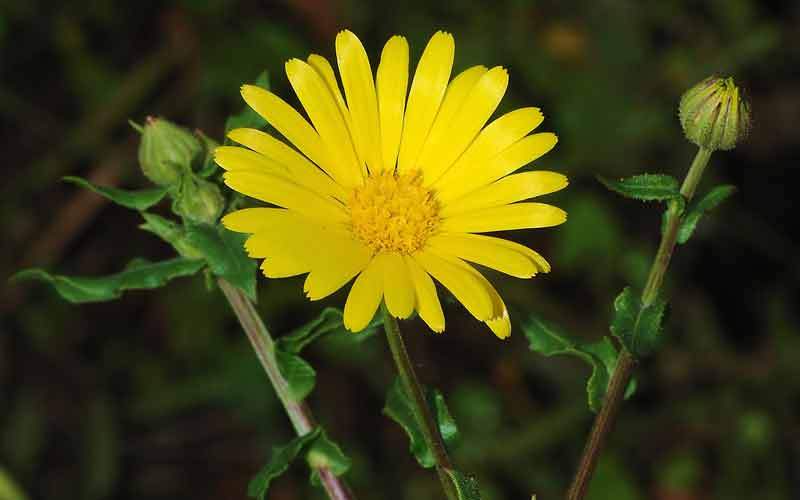The Calendula is Blooming!

As autumn advances here in the beautiful Pacific Northwest, many leaves turn bright colors, but very little other color is visible. Our sunflowers have fallen over, the last of our golden tomatoes have been harvested, pumpkins are out on porches. Still, the bright orange and yellow calendula flowers—volunteers in our garden, this year—remain vibrant! In fact, the name Calendula is said to refer to the perpetual flowering of this hardy plant throughout all the months of the calendar in many regions, where it is perennial. In more temperate areas, it’s grown as an annual, flowering from June until killed by frost.
Calendula is known to kitchen gardeners as an edible flower, adding its bright color to salads and many other dishes. Historically, the pot marigold has been used in Greek, Roman, Middle Eastern, and Indian culture as a medicine, food, and dye.
The many names by which it bas been called testify to its ancient and widespread presence in the world: Pot Marigold, Summer’s Bride, Husbandman’s Dial, Holigold, Marybud, Marygold, Bride of the Sun, Spousa Solis, Golds, bull flower; butterwort, care, cowbloom, drunkard, golden flower of Mary, gouls, goulans, kingcups, holygold, sun’s bride, water dragon, yolk of egg, poet’s marygold, publican and sinner, ruddles, Scotch marigold, shining herb, solsequia, Gold; Ringelblume, Studentenblume, Totenblume, Goldblume (German); souci (French); calendula (Italian); Nagietek lekarski (Polish); goedsbloem- wratten-kruid (Dutch); calendula gialla, fiorrancio, calenzola (Italian); calendula, flamenquilla, maravilla, flor de muerto (Spanish); maravilhas, marianas (Portuguese); ringblomma (Swedish); nogotki, lekarstvennye (Russian); chin-chan-hua (Chinese); janvah, azariyunah, azarboya (Arabic).
Early medical writings note its use for digestive tract ailments including colitis and peptic ulcers, detoxifying the liver and gall bladder, and for relieving muscle spasms, in addition to topical applications as an antiseptic, antihemorrhagic, and astringent.
Calendula extracts have been used to treat headaches, toothaches, gingivitis, eye inflammations, consumption, tumors, menstrual irregularities and other gynecological issues (it has a mildly estrogenic action), and scorpion bites. The rich color of “the poor man’s saffron” has lent its golden hues to butter, cheeses, and hair dyes.
Calendula officinialis flowers are best known as a remarkable vulnerary, gently disinfecting, reducing inflammation, and aiding the healing of cuts, scrapes, and wounds. Its antibacterial, antifungal, and immune promoting properties are widely recognized.
Active ingredients found in calendula flowers include phenolic compounds (such as flavonoids and coumarins), steroids, terpenoids, carbohydrates, lipids, tocopherols, quinones, carotenes, essential oils, fatty acids, and minerals.
Em’s Herbals provides beautiful whole organic Pacific Northwest grown Calendula blossoms, perfect for creating your own poultices, tinctures, and cosmetic blends. We also offer a premium Calendula Oil, organic jojoba oil infused with calendula, excellent for diaper rashes, eczema, and other skin irritations, as well pure Calendula Salve, a rich, buttery product that combines the infused oil with fair trade organic virgin unrefined Shea Butter, virgin unrefined organic coconut oil, and organic beeswax, a remarkable application for cuts. scratches, abrasions, and other inflamed skin surfaces.
Also in News

Why We Love St. John’s Wort
At Em’s Herbals, we have a deep appreciation for plants that not only support wellness but also remind us of nature’s quiet brilliance — and St. John’s Wort is one of those truly special herbs.

Herbal Gifts That Inspire Wellness!
Gift-giving season is here, and if you’re looking for something thoughtful, nourishing, and truly from the heart, we’ve got you covered!

Seven Herbs Traditionally Used to Support Moms After Birth
Becoming a mother is one of life’s most profound transitions. While the joy of holding your baby is unmatched, the postpartum journey can also bring physical recovery, emotional shifts, and sheer exhaustion. Herbs have been traditionally used for centuries to provide gentle nourishment and support for mothers in this tender stage of life!
